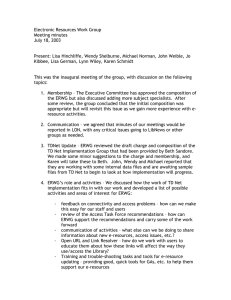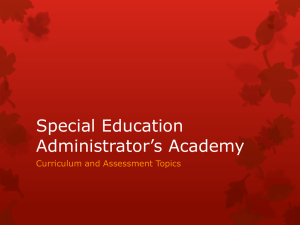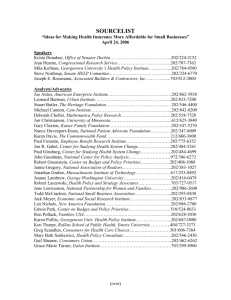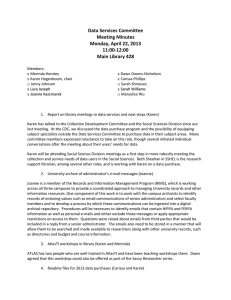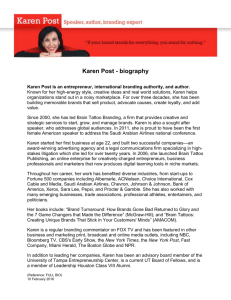Terese Gagnon Surveying the Landscape of Research:
advertisement
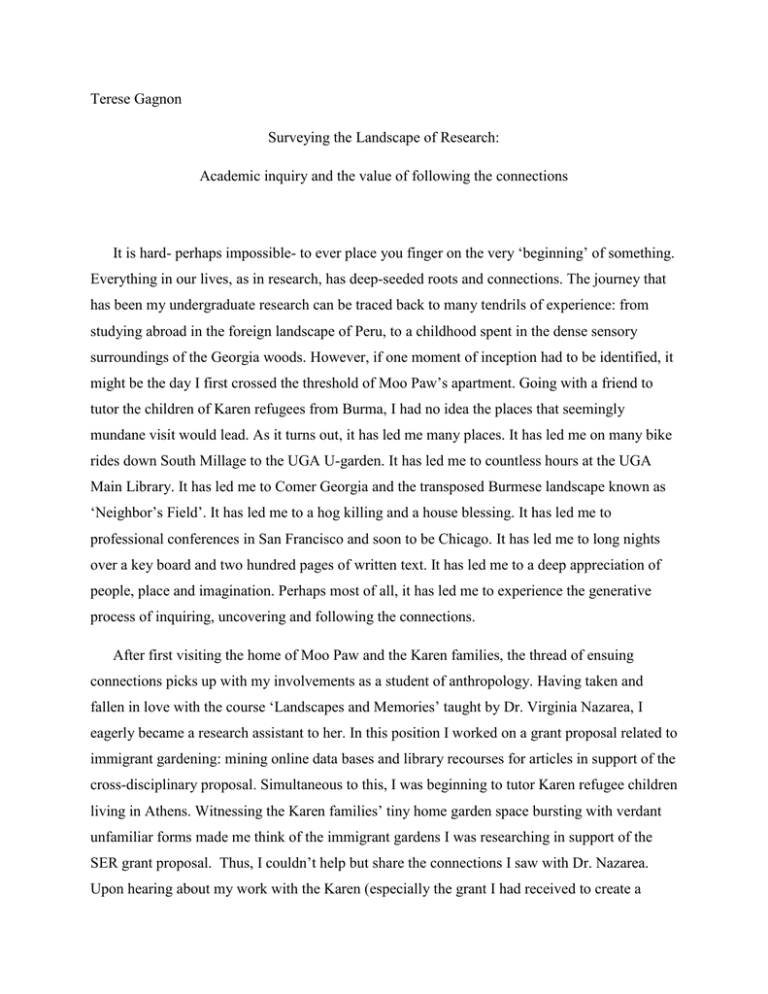
Terese Gagnon Surveying the Landscape of Research: Academic inquiry and the value of following the connections It is hard- perhaps impossible- to ever place you finger on the very „beginning‟ of something. Everything in our lives, as in research, has deep-seeded roots and connections. The journey that has been my undergraduate research can be traced back to many tendrils of experience: from studying abroad in the foreign landscape of Peru, to a childhood spent in the dense sensory surroundings of the Georgia woods. However, if one moment of inception had to be identified, it might be the day I first crossed the threshold of Moo Paw‟s apartment. Going with a friend to tutor the children of Karen refugees from Burma, I had no idea the places that seemingly mundane visit would lead. As it turns out, it has led me many places. It has led me on many bike rides down South Millage to the UGA U-garden. It has led me to countless hours at the UGA Main Library. It has led me to Comer Georgia and the transposed Burmese landscape known as „Neighbor‟s Field‟. It has led me to a hog killing and a house blessing. It has led me to professional conferences in San Francisco and soon to be Chicago. It has led me to long nights over a key board and two hundred pages of written text. It has led me to a deep appreciation of people, place and imagination. Perhaps most of all, it has led me to experience the generative process of inquiring, uncovering and following the connections. After first visiting the home of Moo Paw and the Karen families, the thread of ensuing connections picks up with my involvements as a student of anthropology. Having taken and fallen in love with the course „Landscapes and Memories‟ taught by Dr. Virginia Nazarea, I eagerly became a research assistant to her. In this position I worked on a grant proposal related to immigrant gardening: mining online data bases and library recourses for articles in support of the cross-disciplinary proposal. Simultaneous to this, I was beginning to tutor Karen refugee children living in Athens. Witnessing the Karen families‟ tiny home garden space bursting with verdant unfamiliar forms made me think of the immigrant gardens I was researching in support of the SER grant proposal. Thus, I couldn‟t help but share the connections I saw with Dr. Nazarea. Upon hearing about my work with the Karen (especially the grant I had received to create a Karen market garden at UGA‟s U-garden) Dr.Nazarea encouraged that I pursue a CURO research project. Eagerly I took up the mantel, deciding to focus on my fascination with the connection between landscape, memory and imagination. Since then, it has been a long, challenging, and fruitful road of following one connection to the next. One of the most critical moments in my research processes was my meeting with UGA research librarian, Caroline Barratt. During this meeting, Ms. Barratt shared with me and fellow researcher Aida, strategies for utilizing library resources. She taught us skills for honing search results in online databases, finding materials related to our topics from a broad range of perspectives, storing and organizing bibliographic information, locating multi-media resources, and more. Two of the most instrumental resources she introduced to us were WorldCat, the most broad-reaching materials search available, and Refworks, an incredibly convenient site for recording and organizing bibliographic material. Both of these became key tools in my research. In addition to the many useful detailed tips Ms. Barratt gave to us that day- using iterative phrasing, employing synonyms is searches- she also emphasized the value of working the connections. She encouraged that upon finding one useful article or book, we tap any links to further sources. For me this advice proved monumental. While it might seem only basic, previously I had never fully combed citations of works to find other even potentially more relevant sources. Fully embracing this method came to be perhaps the most transformative element in my approach to research. During that very meeting, Ms. Barratt illustrated the tangible value of everything she had demonstrated, by using WorldCat and adept phrasing to locate for me a book on the trees, shrubs and climbing plants of Myanmar. While that book itself, in the end proved outdated and limited in its usefulness, it lead me on the trail of a man named John Kress - the first English speaking botanist to visit Burma in over 200 years. His work “The Weeping Goldsmith” later became critical to my understanding of the cultural and natural landscape of Burma. Thus, with my research toolkit well lined, I dove headfirst into the literature. I set about the task of „reading around‟ the topic of my research: exploring themes of place-making, phenomenology, transnationalism, memory, sensory experience, food, landscape and cultural imagination. I began the all-consuming process of seeking to synthesizing the literature and slowly feeling out the proverbial „gap‟ that would mark my contribution to the existing thought. At this point the seminal works which I drew on included the writings of Rick Van Noy, C. Nadia Seremetakis, Krishnindu Ray, and Paul Stoller. In addition to these great academic minds, I drank inspiration from themes of place and memory as expressed in the poetry and fiction of my literary heroes Wendell Berry and Naomi Shihab Nye. At this stage in my research I created a written lit review, which I presented to my mentor professor and fellow researchers for critique and discussion. Towards the end of this first semester of research, I presented my research approach and initial findings at the CURO undergraduate research Symposium: my first experience participating in an official academic conference. As culmination to semester one of my CURO research I wrote a roughly forty page paper, detailing my synthesis of the literature, research methods, data and early conclusions. My research was particularly engaging to me because it included not only a reading of captivating anthropological theory but it also centered around my relationships with the Karen people I had come to know and care about. My physical research consisted of spending time in their homes and gardens, listening to their dreams and stories, cooking with them in their kitchens and cultivating at their side the familiar plants of their Burmese homeland. My research experience grew exponentially more significant as I found out I was selected as a CURO summer fellow. This meant that I could have the freedom to dedicate myself fulltime to research over a span of three months. Through this phenomenal opportunity I filled my days: spending time at the Karen market garden with Moo Paw, San Nie and the Karen plants we grew there, luxuriating in the ability to read book after book on everything from the botany of Burma, Karen culture, Myanmar political violence, environmental philosophy and ecophenomenology. I followed an exciting trail in which one work perpetually lead me to another: Ray leading me to Rushdie and Proust, Seremetakis leading me to Bell-Hooks and Van Noy leading me to Stegner. I found great delight in exploiting the rich resources of the Georgia Library System, greedily borrowing books through GIL Express like ordering from a Christmas catalogue. I even went prolonged UGA library scavenger hunt, in search of a particular book about „maps of the imagination‟, rumored to be located at the rather elusive UGA Map library. Even my „down time‟ was research related, as I picked up recreational fiction books related to Burma, such as the beautiful story The Piano Tuner and books dealing with place, memory and immigrants, such as Willa Cather‟s Shadows on the Rock. However, the highlight of my CURO summer fellowship was the two plus weeks spent in „the field‟, living at the intentional community of Jubilee Partners in Comer, Georgia. There many of the Karen refugees Jubilee has helped acclimate to the U.S. have permanently settled and now tend a verdant patch of Burma known as „Neighbor‟s Field‟. This community gardenwhere roughly twelve Karen families tend poetic plots of practical imagination- became the site of my most crucial research. There, I spent hours on end walking the garden, examining plants, speaking with the Karen people and members of Jubilee about what was being grown. I took photographs for my Karen plant compendium. I also spend a great deal of time in the homes of Karen families, cooking and eating with them and listening to their stories. During my time there I partook in the memorable events of a traditional Karen style pig butchering (an experience I won‟t soon forget) as well as the festive gathering of over a hundred, mostly Karen, people for the house blessing ceremony of my friend Moo Paw‟s new home. Returning from my time in Comer, I further tapped the network of the literature I had already been pursuing. The sources I had richly been mining yielded new threads of insight and connectivity. Also, while perusing the shelves of the main library for a particular book, I stumbled totally by accident upon a work titled Strange Beauty. This dense and beautiful text came to richly inform my perspectives on the role of myth and landscape. It introduced me to the fascinating concept of „Eco-Poesies‟ and lead me to the work of French philosopher MerluPonty, relating to the „the flesh of the world‟. Both of which became central to my thesis and interpretation of the Karen people‟s weaving of place and imagination. Since my summer fellowship my research work has culminated in the phenomenal experience of presenting at the American Anthropological Association‟s annual meeting in San Francisco (where I grew not only from my own presentation experience but also from the stimulating opportunity to be exposed to the work of countless brilliant minds) and in the writing of my recently completed CURO thesis. My thesis has come to occupy the form of two separate works. The first is a purely academic thesis titled „Landscapes of the Interior‟ including a Karen plant compendium and memory maps. The second is a more creative piece called the „Karen Gardening Scrapbook”. It seeks to pick up where the academic work leaves off…carrying out the practical work of breathing life into memory through poetry, photographs and „How To‟ guides that seek to preserve the texture of Karen culture and experience. I now look forward to being a part of a professional research panel on the „public and private life of seeds‟ for the upcoming AAA conference in Chicago. As encouraged by my mentor professor, I also plant to submit my thesis to an academic journal for possible publication. Both of these experiences I know will only further the wonderful learning I have already undergone. All in all, this research process has been an incredible journey. It has helped me to grow as a scholar and as an individual. Through it, I have learned much about the work of utilizing resources and following trails of academic thought. I have discovered the excitement of tapping into big questions and celebrating the most miniscule of details. I have pushed myself further than I anticipated I could go: reading literally thousands of pages and writing two hundred of my own. I have come to deeply know and appreciate the themes on which my research focuses, as well as the lives of the beautiful people who stand at the center of it. Through the process of conducting undergraduate research- with the help of many- I have come to witness the power of following the connections. From where I stand now, I behold the beautiful landscape of where the connections can lead. Academic Abstract: Landscapes of the Interior Forced by ongoing government persecution to leave their homeland in Burma, Karen refugees residing in Georgia continue each day the process of remembering and reaffirming their cultural traditions while seeking meaning and belonging in their new environment. Through engaging in interviews and gardening practices with the Karen people this project examines the anthropological phenomenon of the „landscape of the interior‟, particularly as experienced from a transnational perspective. Recognizing the value of preserving genetic biodiversity alongside culturally situated knowledge, it aims to record- through the process of memory banking ethnobotanical traditions of the Karen and their cultural relationship to the natural environment. One important product of this research is a compendium of plant species grown by Karen gardeners in Georgia. This compendium includes plant characteristics, methods of cultivation, uses, religious/cultural significance and photo documentation. Additionally, this project explores the role of „interior landscapes‟ in shaping relationships with a new inhabited environment. This investigation seeks to benefit the Karen people and the community at large by encouraging the continuation of traditions — creating senses of „rootedness‟ and preserving ethnobotanical knowledge and biodiversity. This research is approached with the belief that practices of remembrance and resilience are often the strongest means of combating forces of hegemony and oppression. Research Bibliography and Thesis Works Cited: Works Cited Anderson, Edward F. 1993. Plants and people of the golden triangle: Ethnobotany of the hill tribes of northern thailandDioscorides Press. Appaduri, Arjun. 1991. Global ethnoscapes: Notes and queries for a transnational anthropology. Recapturing anthropology: Working in the present. Santafe, NM: School of American Research Press. Cronon, William ed., Uncommon Ground: Rethinking the Human Place in Nature, New York: W. W. Norton & Co., 1995, 69-90 Drum Publication Group: Promoting Education, Preserving Culture, "Drum Publication Group Website." Accessed September, 12, 2012. http://www.drumpublications.org/index.html. Feld, Steven, and Keith H. Basso. c1996. Senses of place /. School of American research advanced seminar series. 1st ed. ed. Santa Fe, N.M.: School of American Research Press; Gustafson, P. 2001. “Meaning of Place: Everyday Experience and Theoretical Conceptulizations.” Journal of Environmental Psychology, 21: 5-16 Kress, John W. The Weeping Goldsmith: Discoveries in the Secret Land of Myanmar. Abbeville Press, 2009. Merleau-Ponty, Maurice. The Visible and the Invisible. Evanston, Illinois: Northwestern University Press, 1968. Mo Paw, (Gardening Interview), interview by Terese Gagnon, Athens, Ga03 2012. Nazarea, Virginia. c1998. Cultural memory and biodiversity /. Tucson: University of Arizona Press. Nazarea, Virginia D. c2005. Heirloom seeds and their keepers: Marginality and memory in the conservation of biological diversity. Tucson: University of Arizona Press. Nye, Naomi Shihab, and Michael Nye. 1999. What have you lost? / Poems selected by Naomi Shihab Nye; photographs by Michael N ye New York: Greenwillow Books, c1999; 1st Ed Ray, Krishnendu. c2004. The migrant's table: Meals and memories in bengali-american households. Philadelphia: Temple University Press. Sahlins, Marshall David. Islands of History. Chicago: University of Chicago Press, 1987. Saw Wah, David. The CAN Handbook. Thailand: Wanida Press, 2007. Scott, James C. Weapons of the Weak: Everyday Forms of Peasant Resistance. Yale University Press, 2008. Seremetakis, C. Nadia. 1996. The senses still: Perception and memory as material culture in modernity. University of Chicago Press ed. ed. Chicago: University of Chicago Press. Siewers, Alfred K. Strange beauty: ecocritical approaches to early medieval landscape. New York, NY: Palgrave Macmillan, 2009. Silko, Lesli Marmon. Landscape, History and the Pubelo Imagination. The Norton Book of Nature Writing. Edited by Jobert Finch, John Elder. New York, NY: Norton & Company, 1990. Stoller, Paul. 2009. The power of the between: An anthropological odyssey. Chicago: University of Chicago Press. Sutton, David. 2001. Remembrance of repasts: An anthropology of food and memory. Materializing culture. Oxford; Berg. Ta Hay, (Gardening Interview), interview by Terese Gagnon, Athens, Ga 03 2012. Tobin, Beth. "And there raise yams: Slaves' Gardens in the Writings of West Indian Plantocrats." Eighteenth-Century Life . 23. no. 2 (1999). Tomforde, Maren. 2003. The global in the local: Contested resource-use systems of the Karen and Hmong in northern Thailand. Journal of Southeast Asian Studies 34 (2) (Jun.): pp. 347360. Van Noy, Rick. c2003. Surveying the interior: Literary cartographers and the sense of place. Environmental arts and humanities series. Reno: University of Nevada Press. Bibliography On the run: In Burma‟s jungle hell. 2010. World Policy Journal 27 (1) (Spring2010): 57. Airriess, Christopher A., and David L. Clawson. 1994. Vietnamese market gardens in New Orleans. Geographical Review 84 (1) (Jan.): pp. 16-31. Anderson, Edward F. 1993. Plants and people of the golden triangle: Ethnobotany of the hill tribes of northern thailandDioscorides Press. Appaduri, Arjun. 1991. Global ethnoscapes: Notes and queries for a transnational anthropology. Recapturing anthropology: Working in the present. Santafe, NM: School of American Research Press. Baker, Lauren E. 2004. Tending cultural landscapes and food citizenship in Toronto‟s community gardens. Geographical Review 94 (3) (07): 305-25. Benjamin, David N., David Stea, and Eje Ar n. 1 . The home: Words, interpretations, meanings and environments. Ethnoscapes (unnumbered). Aldershot: Avebury. Berry, Wendell. 2010. Imagination in place: Essays / Wendell berry Berkeley: Counterpoint: Distributed by Publishers Group West, c2010. Brussell, David E. 1997. Potions, poisons, and panaceas: An ethnobotanical study of Montserrat Southern Illinois University Press. Bryant, Raymond L. 1996. Romancing colonial forestry: The discourse of 'forestry as progress' in British Burma. The Geographical Journal 162 (2) (Jul.): pp. 169-178. Bryce, J. Annan. 1886. Burma: The country and people. Proceedings of the Royal Geographical Society and Monthly Record of Geography 8 (8) (Aug.): pp. 481-501. Buff, Rachel Ida. 2005. Transnational visions: Reinventing immigration studies. American Quarterly 57 (4) (Dec.): pp. 1263-1272. Busch, Akiko. c1999. Geography of home: Writings on where we live. New York: Princeton Architectural Press. C ndida Smith, ichard. 2002. Art and the performance of memory: Sounds and gestures of recollection. Routledge studies in memory and narrative; London; Routledge. Chavez, Leo R. 1994. The power of the imagined community: The settlement of undocumented Mexicans and Central Americans in the United States. American Anthropologist 96 (1) (Mar.): pp. 52-73. Christie, Maria Elisa. 2004. Kitchen space, fiestas, and cultural reproduction in Mexican houselot gardens. Geographical Review 94 (3, People, Places, & Gardens) (Jul.): pp. 368-390. Cisneros, Sandra. 1994. The house on mango street / Sandra Cisneros New York: A.A. Knopf: Distributed by Random House, 1994; 1st hardcover Ed. Comida y Cultura, "Food as a Weapon of War?!." Last modified Novemebr 25, 2009 . Accessed November 12, 2012. Corlett, Jan L., Ellen A. Dean, and Louis E. Grivetti. 2003. Hmong gardens: Botanical diversity in an urban setting. Economic Botany 57 (3) (autumn): pp. 365-379. Cronon, William ed., Uncommon Ground: Rethinking the Human Place in Nature, New York: W. W. Norton & Co., 1995, 69-90 Daniel, Yvonne. c2005. Dancing wisdom: Embodied knowledge in Haitian vodou . Urbana: University of Illinois Press. Desbarats, Jacqueline. 1985. Indochinese resettlement in the United States. Annals of the Association of American Geographers 75 (4) (Dec.): pp. 522-538. Drum Publication Group: Promoting Education, Preserving Culture, "Drum Publication Group Website." Accessed September, 12, 2012. http://www.drumpublications.org/index.html. Feld, Steven, and Keith H. Basso. c1996. Senses of place /. School of American research advanced seminar series. 1st ed. ed. Santa Fe, N.M.: School of American Research Press; Foley, Neil. 1999. We met in spinach, fell in love in peaches, and married in tomatoes. Reviews in American History 27 (2) (Jun.): pp. 282-288. FUERTES, A. L. 2010. Birds inside a cage: Metaphor for Karen refugees. Social Alternatives 29 (1) (2010): 20. Haines, David W. 1982. Southeast Asian refugees in the United States: The interaction of kinship and public policy. Anthropological Quarterly 55 (3, Southeast Asian Refugees in the U.S.A.: Case Studies of Adjustment and Policy Implications) (Jul.): pp. 170-181. Harmon, Katharine A. c2004. You are here: Personal geographies and other maps of the imagination. 1st ed. Ed. New York: Princeton Architectural Press. Hayami, Yoko. 1996. Karen tradition according to Christ or Buddha: The implications of multiple reinterpretations for a minority ethnic group in Thailand. Journal of Southeast Asian Studies 27 (2) (Sep.): pp. 334-349. Hoffman, Arnold Roy,. 1970. The sense of place: Peter de vries, J. F. powers, and Flannery O’ . Hooks, Bell. 2008. Belonging: A culture of place. New York: Routledge. Huyck, Earl E., and Leon F. Bouvier. 1983. The demography of refugees. Annals of the American Academy of Political and Social Science 467 (, The Global Refugee Problem: U. S. and World Response) (May): pp. 39-61. Jha, S., and K. S. Bawa. 2006. Population growth, human development, and deforestation in biodiversity hotspots. Conservation Biology 20 (3) (Jun.): pp. 906-912. Keck, Stephen L. 2004. Picturesque Burma: British travel writing 1890-1914. Journal of Southeast Asian Studies 35 (3) (Oct.): pp. 387-414. KENNY, PAUL, and KATE LOCKWOOD-KENNY. 2011. A mixed blessing: Karen resettlement to the United States. Journal of Refugee Studies 24 (2) (06): 217-38. Khin, U. S. Some medicinal and useful plants, both indigenous and exotic, of Burma [1st Ed. In Rangoon, Student Press 1970]. Kimber, Clarissa T. 2004. Gardens and dwelling: People in vernacular gardens. Geographical Review 94 (3, People, Places, & Gardens) (Jul.): pp. 263-283. Klindienst, Patricia. c2006. The earth knows my name: Food, culture, and sustainability in the gardens of ethnic Americans. Boston: Beacon Press. Knopp, Lisa,. 2002. The nature of home /. Lincoln: University of Nebraska Press. Kress, W. J., and J. H. Lace. 2003. A checklist of the trees, shrubs, herbs, and climbers of Myanmar : (revised from the original works by J.H. lace ... [et al.] on the list of trees, shrubs, herbs and principal climbers, etc., recorded from Burma)Washington, D.C. : Dept. of Systematic Biology--Botany, National Museum of National History, 2003. Kuebel, K. R., and Arthur O. Tucker. 1988. Vietnamese culinary herbs in the United States. Economic Botany 42 (3) (Jul. - Sep.): pp. 413-419. Kuroiwa, Yoko, and Maykel Verkuyten. 2008. Narratives and the constitution of a common identity: The Karen in Burma. Identities 15 (4) (Jul): 391-412. Mels, Tom, and Gunhild Setten. 2007. Romance, practice and substantiveness: What do landscapes do? Geografiska Annaler.Series B, Human Geography 89 (3): pp. 197-202. Mendoza, Cristóbal. 2006. Transnational spaces through local places: Mexican immigrants in Albuquerque (New Mexico). Journal of Anthropological Research 62 (4) (Winter): pp. 539561. Merleau-Ponty, Maurice. The Visible and the Invisible. Evanston, Illinois: Northwestern University Press, 1968. Mortland, Carol A., and Judy Ledgerwood. 1987. Secondary migration among Southeast Asian refugees in the United States. Urban Anthropology and Studies of Cultural Systems and World Economic Development 16 (3/4, Southeast Asian Refugees in the United Sates) (FALL-WINTER): pp. 291-326. Nazarea, Virginia D. c2005. Heirloom seeds and their keepers: Marginality and memory in the conservation of biological diversity. Tucson: University of Arizona Press. ———. c1999. Ethnoecology: Situated knowledge located lives. Tucson: University of Arizona Press. ———. c1998. Cultural memory and biodiversity /. Tucson: University of Arizona Press. ———. c1997. Yesterday's ways, tomorrow's treasures: Heirloom plants and memory banking. Dubuque, Iowa: Kendall/Hunt Pub. ———. 2003. Costumbres del ayer, tesoros del mañana: Plantas de herencia, conocimientos ancestrales y bancos de memoria. 1. ed. ed. Quito, Ecuador: Abya-Yala. ———. [2003]. . 1. ed. ed. Quito, Ecuador: Ediciones ABYA-YALA. Nye, Naomi Shihab. 2011. When one is so far from home, life is a mix of fact & fiction. Midwest Quarterly 52 (3) (Spring2011): 279-. ———. 1995. Words under the words: Selected poems / Naomi shih Nye Portland, or. : Eighth Mountain Press; [St. Paul, Minn.]: Distributed to the trade by Consortium Book Sales & Distribution, 1995; 1st Ed. Nye, Naomi Shihab, and Michael Nye. 1999. What have you lost? / Poems selected by Naomi Shihab Nye; photographs by Michael Nye New York: Greenwillow Books, c1999; 1st Ed. Park, Keumjae. 2007. Constructing transnational identities without leaving home: Korean immigrant women's cognitive border-crossing. Sociological Forum 22 (2) (Jun.): pp. 200218. Piniero, Maricel Castillo,. 2002. Biodiversity and marginality dilemma of economic development. Porcello, Thomas, Louise Meintjes, Ana Maria Ochoa, and David W. Samuels. 2010. The reorganization of the sensory world. Annual Review of Anthropology 39 : pp. 51-66. Pritchard, James. 2006. [Untitled]. The Western Historical Quarterly 37 (2) (Summer): pp. 221222. Ray, Krishnendu. c2004. The migrant's table: Meals and memories in bengali-american households. Philadelphia: Temple University Press. Sahlins, Marshall David. Islands of History. Chicago: University of Chicago Press, 1987. Saw Wah, David. The CAN Handbook. Thailand: Wanida Press, 2007. Scholliers, Peter. 2001. Food, drink and identity: Cooking, eating and drinking in Europe since the middle ages. Oxford; Berg. Scott, James C. Weapons of the Weak: Everyday Forms of Peasant Resistance. Yale University Press, 2008. Seremetakis, C. Nadia. 1996. The senses still: Perception and memory as material culture in modernity. University of Chicago Press ed. ed. Chicago: University of Chicago Press. Siewers, Alfred K. Strange beauty: ecocritical approaches to early medieval landscape. New York, NY: Palgrave Macmillan, 2009. Stoller, Paul. 2009. The power of the between: An anthropological odyssey. Chicago: University of Chicago Press. Sutton, David E. 2010. Food and the senses. Annual Review of Anthropology 39: pp. 209-223. ———. 2001. Remembrance of repasts: anthropology of food and memory. Materializing culture. Oxford; Berg. Teather, Elizabeth K. 1999. Embodied geographies: Spaces, bodies and rites of passage. Critical geographies; London; Routledge. Thomson, Curtis N. 1995. Political stability and minority groups in Burma. Geographical Review 85 (3) (Jul.): pp. 269-285. Tomforde, Maren. 2003. The global in the local: Contested resource-use systems of the Karen and Hmong in northern Thailand. Journal of Southeast Asian Studies 34 (2) (Jun.): pp. 347360. Van Noy, Rick. c2003. Surveying the interior: Literary cartographers and the sense of place. Environmental arts and humanities series. Reno: University of Nevada Press

